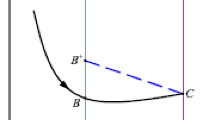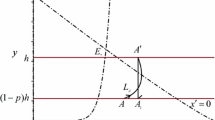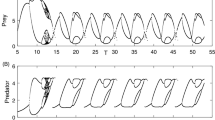Abstract
In this paper, based on a predator–prey model with Holling’s type III functional response, a pest management system with artificial interference is proposed. We assume that the artificial interference strategy will be taken to control pests when their number reaches a certain threshold. Based on this assumption, the artificial interference strategy of the system with nonlinear state feedback control is analyzed by using the geometric theory of ordinary differential equations. We first study the existence of periodic solutions of the model by successor functions and then the stability of periodic solutions. Finally, numerical simulations are given to illustrate our theoretic conclusions.







Similar content being viewed by others
References
United states department of agriculture (2015). www.ars.usda.gov
Author: The pest management regulatory agency of Canada (2015). http://www.hc-sc.gc.ca/cps-spc/pest/index-eng.php
Mahr, D., Ridgway, N.: Biological control of insects and mites: An introduction to beneficial natural enemies and their use in pest management. Information Systems Division, National Agricultural Library 481, (1993)
Hueth, D., Regev, U.: Optimal agricultural pest management with increasing pest resistance. Am. J. Agric. Econ. 56(3), 543–552 (1974)
Whalon, M.E., Mota-Sanchez, D., Hollingworth, R.M.: Global Pesticide Resistance in Arthropods. Commonwealth Agricultural Bureaux International, Cambridge (2008)
Ehler, L.E.: Integrated pest management (IPM): definition, historical development and implementation, and the other IPM. Pest Manag. Sci. 62(9), 787–789 (2006)
Hardin, M.R., Benrey, B., Coll, M., Lamp, W.O., Roderick, G.K., Barbosa, P.: Arthropod pest resurgence: an overview of potential mechanisms. Crop Prot. 14(1), 3–18 (1995)
Smith, R.F., Reynolds, H.T.: Principles, definitions and scope of integrated pest control. Food and Agriculture Organization of the United Nations (1966)
Kogan, M.: Integrated pest management: historical perspectives and contemporary developments. Annu. Rev. Entomol. 43(1), 243–270 (1998)
Apple, J.L., Smith, R.F.: Integrated Pest Management. Springer, Berlin (1976)
Dent, D., Elliott, N.C.: Integrated Pest Management. Springer Science & Business Media, Berlin (1995)
Hassanali, A., Herren, H., Khan, Z., Pickett, J., Woodcock, C.: Integrated pest management: the push–pull approach for controlling insect pests and weeds of cereals, and its potential for other agricultural systems including animal husbandry. Philos. Trans. R. Soc. B Biol. Sci. 363(1491), 611–621 (2008)
Lenteren, J.C.V., Woets, J.: Biological and integrated pest control in greenhouses. Annu. Rev. Entomol. 33(1), 239–269 (1988)
Lewis, W.J., van Lenteren, J.C., Phatak, S.C., Tumlinson, J.H.: A total system approach to sustainable pest management. Proc. Natl. Acad. Sci. 94(23), 12243–12248 (1997)
Thomas, M.B.: Ecological approaches and the development of truly integrated pest management. Proc. Natl. Acad. Sci. 96(11), 5944–5951 (1999)
Bahar, A., Mao, X.: Stochastic delay Lotka–Volterra model. J. Math. Anal. Appl. 292(2), 364–380 (2004)
Hong, K., Weng, P.: Stability and traveling waves of diffusive predator–prey model with age-structure and nonlocal effect. J. Appl. Anal. Comput. 2(2), 173–192 (2012)
Li, Y., Kuang, Y.: Periodic solutions of periodic delay Lotka–Volterra equations and systems. J. Math. Anal. Appl. 255(1), 260–280 (2001)
Liu, X., Chen, L.: Complex dynamics of Holling type II Lotka–Volterra predator–prey system with impulsive perturbations on the predator. Chaos Solitons Fractals 16(2), 311–320 (2003)
Meng, X., Liu, R., Zhang, T.: Adaptive dynamics for a non-autonomous Lotka–Volterra model with size-selective disturbance. Nonlinear Anal.: Real World Appl. 16, 202–213 (2014)
Peng, Y., Zhang, T.: Turing instability and pattern induced by cross-diffusion in a predator–prey system with allee effect. Appl. Math. Comput. 275, 1–12 (2016). doi:10.1016/j.amc.2015.11.067
Sambathy, M., Balachandran, K.: Spatiotemporal dynamics of a predator–prey model incorporating a prey refuge. J. Appl. Anal. Comput. 3(1), 71–80 (2013)
Takeuchi, Y.: Global Dynamical Properties of Lotka–Volterra Systems. World Scientific, Singapore (1996)
Yuan, S., Xu, C., Zhang, T.: Spatial dynamics in a predator–prey model with herd behavior. Chaos 23(3), 033102 (2013)
Zhang, T., Hong, Z.: Delay-induced Turing instability in reaction–diffusion equations. Phys. Rev. E 90(5), 052908 (2014)
Zhang, T., Xing, Y., Zang, H., Han, M.: Spatio-temporal dynamics of a reaction–diffusion system for a predator–prey model with hyperbolic mortality. Nonlinear Dyn. 78(1), 265–277 (2014)
Hui, J., Zhu, D.: Dynamic complexities for prey-dependent consumption integrated pest management models with impulsive effects. Chaos Solitons Fractals 29(1), 233–251 (2006)
Jiao, J., Chen, L., Cai, S.: Impulsive control strategy of a pest management SI model with nonlinear incidence rate. Appl. Math. Model. 33(1), 555–563 (2009)
Li, Z., Chen, L., Huang, J.: Permanence and periodicity of a delayed ratio-dependent predator–prey model with Holling type functional response and stage structure. J. Comput. Appl. Math. 233(2), 173–187 (2009)
Liu, B., Zhang, Y., Chen, L.: The dynamical behaviors of a Lotka–Volterra predator–prey model concerning integrated pest management. Nonlinear Anal.: Real World Appl. 6(2), 227–243 (2005)
Meng, X., Chen, L.: Permanence and global stability in an impulsive Lotka–Volterra N-species competitive system with both discrete delays and continuous delays. Int. J. Biomath. 01(02), 179–196 (2008)
Meng, X., Jiao, J., Chen, L.: The dynamics of an age structured predator–prey model with disturbing pulse and time delays. Nonlinear Anal.: Real World Appl. 9(2), 547–561 (2008)
Shi, R., Jiang, X., Chen, L.: A predator–prey model with disease in the prey and two impulses for integrated pest management. Appl. Math. Model. 33(5), 2248–2256 (2009)
Song, X., Hao, M., Meng, X.: A stage-structured predator–prey model with disturbing pulse and time delays. Appl. Math. Model. 33(1), 211–223 (2009)
Sun, S., Chen, L.: Mathematical modelling to control a pest population by infected pests. Appl. Math. Model. 33(6), 2864–2873 (2009)
Zhang, H., Chen, L., Nieto, J.J.: A delayed epidemic model with stage-structure and pulses for pest management strategy. Nonlinear Anal.: Real World Appl. 9(4), 1714–1726 (2008)
Zhang, T., Meng, X., Song, Y.: The dynamics of a high-dimensional delayed pest management model with impulsive pesticide input and harvesting prey at different fixed moments. Nonlinear Dyn. 64(1–2), 1–12 (2011)
Braverman, E., Liz, E.: Global stabilization of periodic orbits using a proportional feedback control with pulses. Nonlinear Dyn. 67(4), 2467–2475 (2012)
Kristiansen, R., Nicklasson, P.J.: Spacecraft formation flying: a review and new results on state feedback control. Acta Astronaut. 65(11–12), 1537–1552 (2009)
Li, N., Cao, J.: New synchronization criteria for memristor-based networks: adaptive control and feedback control schemes. Neural Netw. 61, 1–9 (2015)
Naifar, O., Ben Makhlouf, A., Hammami, M., Ouali, A.: State feedback control law for a class of nonlinear time-varying system under unknown time-varying delay. Nonlinear Dyn. 82(1–2), 349–355 (2015)
Song, S., Zhu, Q.: Noise suppresses explosive solutions of differential systems: a new general polynomial growth condition. J. Math. Anal. Appl. 431(1), 648–661 (2015)
Tang, S., Pang, W., Cheke, R., Wu, J.: Global dynamics of a state-dependent feedback control system. Adv. Differ. Equ. 2015(1), 322 (2015)
Tang, S., Tang, B., Wang, A., Xiao, Y.: Holling ii predator–prey impulsive semi-dynamic model with complex poincaré map. Nonlinear Dyn. 81(3), 1575–1596 (2015)
Wang, H., Zhu, Q.: Finite-time stabilization of high-order stochastic nonlinear systems in strict-feedback form. Automatica 54, 284–291 (2015)
Yagasaki, K.: A simple feedback control system: bifurcations of periodic orbits and chaos. Nonlinear Dyn. 9(4), 391–417 (1996)
Zhang, T., Ma, W., Meng, X., Zhang, T.: Periodic solution of a prey–predator model with nonlinear state feedback control. Appl. Math. Comput. 266, 95–107 (2015)
Zhang, T., Meng, X., Liu, R., Zhang, T.: Periodic solution of a pest management Gompertz model with impulsive state feedback control. Nonlinear Dyn. 78(2), 921–938 (2014)
Zhao, Y., Xu, J.: Using the delayed feedback control and saturation control to suppress the vibration of the dynamical system. Nonlinear Dyn. 67(1), 735–753 (2012)
Zhu, Q.: Asymptotic stability in the pth moment for stochastic differential equations with Lévy noise. J. Math. Anal. Appl. 416(1), 126–142 (2014)
Zhu, Q., Cao, J., Rakkiyappan, R.: Exponential input-to-state stability of stochastic Cohen–Grossberg neural networks with mixed delays. Nonlinear Dyn. 79(2), 1085–1098 (2015)
Tang, S., Cheke, R.A.: State-dependent impulsive models of integrated pest management (IPM) strategies and their dynamic consequences. J. Math. Biol. 50(3), 257–292 (2005)
Tang, S., Xiao, Y., Chen, L., Cheke, R.: Integrated pest management models and their dynamical behaviour. Bull. Math. Biol. 67(1), 115–135 (2005)
Zhang, Y., Zhang, Q., Zhang, X.: Dynamical behavior of a class of prey–predator system with impulsive state feedback control and Beddington-DeAngelis functional response. Nonlinear Dyn. 70(2), 1511–1522 (2012)
Pang, G., Chen, L.: Periodic solution of the system with impulsive state feedback control. Nonlinear Dyn. 78(1), 743–753 (2014)
Gang, W., Sanyi, T.: Qualitative analysis of prey–predator model with nonlinear impulsive effects. Appl. Math. Mech. 34(5), 496–505 (2013)
Chen, J., Zhang, H.: The qualitative analysis of two species predator–prey model with Holling’s type iii functional response. Appl. Math. Mech. 7(1), 77–86 (1986)
Chen, L.: Pest control and geometric theory of semi-continuous dynamical system. J. Beihua Univ. 12(1), 1–9 (2011)
Bainov, D., Simeonov, P.: Impulsive Differential Equations: Periodic Solutions and Applications. CRC Press, Boca Raton (1993)
Lakshmikantham, V., Bainov, D., Simeonov, P.S.: Theory of Impulsive Differential Equations. World Scientific, Singapore (1989)
Arnold, V.: Geometrical Methods in the Theory of Ordinary Differential Equations (Grundlehren der mathematischen Wissenschaften). Springer, New York (1988)
Author information
Authors and Affiliations
Corresponding author
Additional information
This work is supported by the National Natural Science Foundation of China (No. 11371230), Shandong Provincial Natural Science Foundation, China (No. ZR2012AM012, No. ZR2015AQ001), a Project for Higher Educational Science and Technology Program of Shandong Province of China (No. J13LI05), Joint Innovative Center for Safe and Effective Mining Technology and Equipment of Coal Resources, Shandong Province of China and SDUST Research Fund (2014TDJH102).
Rights and permissions
About this article
Cite this article
Zhang, T., Zhang, J., Meng, X. et al. Geometric analysis of a pest management model with Holling’s type III functional response and nonlinear state feedback control. Nonlinear Dyn 84, 1529–1539 (2016). https://doi.org/10.1007/s11071-015-2586-z
Received:
Accepted:
Published:
Issue Date:
DOI: https://doi.org/10.1007/s11071-015-2586-z




